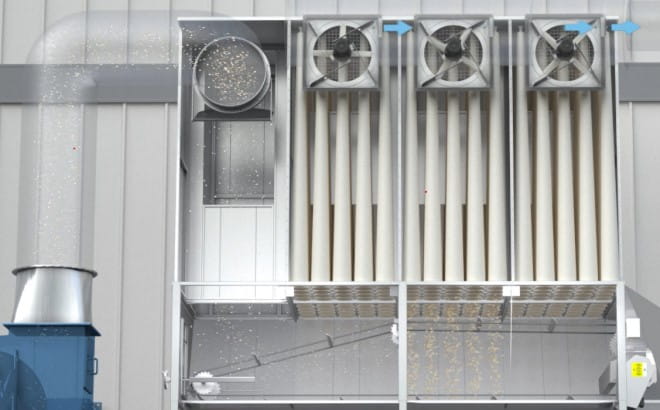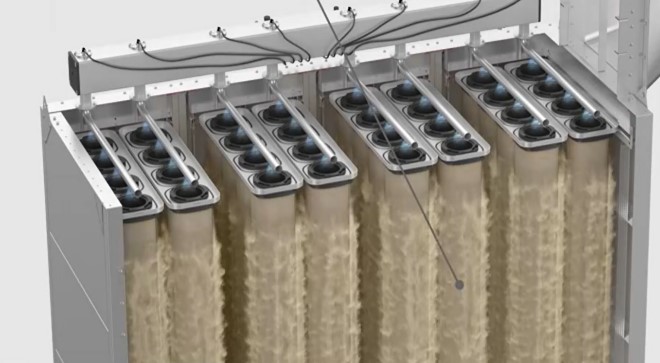The two most prominent style of baghouses are referred to as Reverse Air and Pulse Jet baghouses. While often considered “equivalent” during evaluations, there are substantial differences in performance that impact a variety of operational parameters including operating costs, maintenance intervals, noise level, system reliability and outlet emissions to consider before making a decision.
What is a Reverse Air Baghouse?The name reverse air generally refers to the method used to clean the filters. Dust laden air enters through an inlet module (or hopper) where heavy dust particles drop out of airstream and remaining fine particles are filtered by an array of filter bags on the inside surface. As dust accumulates on the inside surface of the filter bags, regeneration fans located on the clean air side of the filters blows air in the reverse direction exerting force, dislodging the material from the bags. |
 |
What is a Pulse Jet Baghouse?The name pulse jet also refers to the method used to clean the filters. For this style, air enters through an inlet module or hopper but for this arrangement dust is filtered from the outside-in where dust loads on the outside of the filter. To clean these filters, a reservoir of compressed air called a manifold is connected to an array of fixed nozzles or blowpipes directly above the filters (or in a rotating wand on round styles). A solenoid valve opens for a fraction of a second releasing the stored compressed air energy through the nozzles, pressurizing the inside of the filters and dislodging the dust |
 |
| Topic | Reverse Air | Pulse Jet* | What this means? |
|---|---|---|---|
| Filter differential pressure | This style baghosue is typically designed to operate with a filter pressure differential of approximately 300 Pa (1-2 in w.g.) | Typically designed to operate with a filter differential pressure of approximately 800 Pa (3-4 in w.g.) | Higher filter pressure differentials require additional energy to move air. So your extraction fan(s) will consume more electricity to maintian the airflow at higher pressures resulting in higher operating costs. Lower energy consumption also helps achieve more sustainable operations. |
| Filter cleaning maintenance | The regeneration fans are a fixed, direct drive arrangement above the filter bag array. The motor is electrically actuated spinning a fan wheel. | Pulse jet collectors utilize solenoid controlled diaphragm pulse valves to initiate the pulse valves. These valves are susceptable to wear and tear due to frequent cleaning causing leaks and can be susceptible to moisture and freezing. | More frequent maintenance checks and repairs are required to keep pulse-jet collectors operating as intended. Any leak or inefficiency in the cleaning system wastes compressed air which costs more in electricity. |
| Filter life | Filter bag life is generally 5+ years in part because of lower operating pressure, lower velocities and reduced abrasion from dust and cleaning. | Filter life is generally 1-3 years. Pulse-jet collectors often run at higher filter velocities (air-to-media ratios) which increases abrasion and the constant compressed air blasts increase wear on the filter material. | More frequent filter changes increase operating costs and require more downtime for system maintenance. Frequent filter changeouts also impacts sustainability initiatives through increased waste. |
| Noise | The average noise level including the cleaning cycles is approximately 82 dB(A) with higher, intermittent noise levels during cleaning cycles. | The average noise level of a pulse jet is approximately 86 dB(A) but intensity of compressed air blasts can peak at greater than 100 dB(A) on some designs. As filters become more seasoned, pulse cleaning becomes more frequent. | While both noise levels are elevated, the intensity and "bang" associated with pulse jets can be disruptive to factory staff and neighbors. |
| Operational Emissions | When filters are cleaned, airflow is reveresed within the filter module and the force exerted on the bags is mild resulting in very small filter bypass during cleaning. | Each blast of compressed air causes a flexing of the filter material expanding the fibers and allowing a small amount of dust through the filter resulting in emissions. | Higher emissions can impact indoor air quality if returning air to factory, shorten life of secondary filters or impact permitting. Reverse air have lower operating emissions. |
| Expandability | Systems are modular by design with one regeneration fan per module so expanding is straightforward. Some minor wiring or adjustment to control configurations may be required. | Systems can be modular or fully welded which may or may not be able to be expanded. If expand, the compressed air requirement increases which may require upgrades to compressor or controls. | New machinery additions or expansion in factories is a matter of when not if so factoring the ability to expand in initial purchasing decision should be considered to prepare for the future. |
While there is not a “one-size-fits-all solution for industrial dust collection, it is important to understand the operation of available technologies and the impact it will have on the productivity and profitability of your operation. Considering the operating cost of these systems is especially important for dust collection systems as operational cost can significantly outweigh the initial purchase price over the life of the equipment. Reduced energy consumption, less frequent maintenance, lower noise levels and cleaner air are all advantages of reverse air baghouse technology.
Nederman is a global leader in industrial dust collection solutions across a wide range of applications including wood working, composites, agriculture and metal working. For an expert opinion on your new or existing dust collection system, contact Nederman today.
We have extensive experience of various challenges in the different industries and our experts are very skilled, helpful and professional. With us, you can feel secure that we take care of you and your needs. You are always welcome to contact us regardless if you have a short question or a more complex and complicated one. A warm welcome to Nederman.
Contact us here